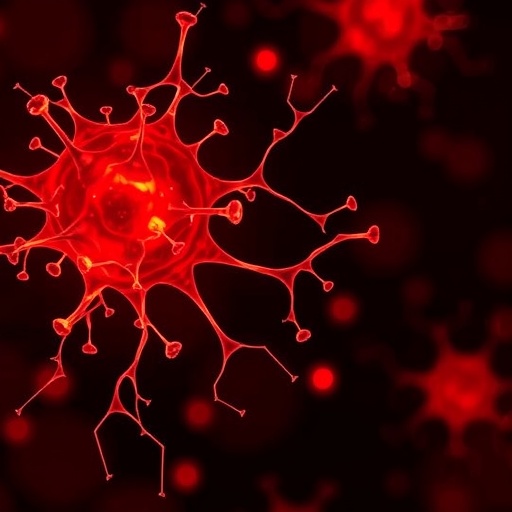In a remarkable stride toward understanding autoimmune diseases, a recent study has unveiled a crucial link between macrophage retrotransposon activity and the early onset of lupus, offering new insights into the intricate pathogenesis of this enigmatic disorder. Systemic lupus erythematosus (SLE) remains a challenging disease to decipher, characterized by complex immune dysregulation and chronic inflammation. While genetic variants impacting reactive oxygen species (ROS) production have been implicated in lupus susceptibility, the precise mechanisms driving immune perturbations have eluded clarity until now.
This groundbreaking research employed a multifaceted approach combining bulk RNA sequencing, flow cytometry, and spatially resolved single-cell transcriptome imaging to thoroughly investigate tissue-resident macrophages in a ROS-deficient lupus-prone mouse model known as lpr. The study’s focal point centered on the expression of mouse transcript family type D (MTD) retrotransposons within macrophages located in pivotal immune organs, including the spleen, kidneys, and the skull dura. The researchers discovered a notable upregulation of MTD retrotransposon expression exclusively in tissue-resident macrophages derived from these sites in ROS-deficient lpr mice.
These findings reveal— for the first time— a direct association between elevated retrotransposon activity and macrophage proliferation in an immunologically compromised environment. Retrotransposons, often dubbed “jumping genes,” are mobile genetic elements capable of inserting themselves into new genomic loci, thereby influencing gene expression and cellular behavior. Their increased activity within macrophages implies a mechanistic pathway wherein retrotransposons might contribute to the aberrant immune activation observed in lupus.
Intriguingly, the study demonstrated that administration of mycophenolate mofetil (MMF), a widely used immunosuppressive agent, for a two-week period significantly diminished MTD retrotransposon expression in these macrophages. This observation underscores a dynamic relationship between therapeutic intervention and retrotransposon-mediated cellular processes. The downregulation of MTD following MMF treatment suggests that retrotransposon expression could serve as a biomarker for therapy efficacy or even as a potential therapeutic target.
Diving deeper into the functional role of MTD retrotransposons, the investigation utilized synthetic MTD-encoded RNA sequences to modulate retrotransposon signaling pathways. By disrupting this signaling, the researchers observed an activation of regulatory T cells (Tregs), a subset of immune cells critically involved in maintaining immune tolerance and preventing autoimmunity. The enhanced Treg activation corresponded with attenuated infiltration of glomerular macrophages and a reduction in serum interleukin-6 (IL-6) levels, a pro-inflammatory cytokine extensively linked to lupus pathogenesis.
These results collectively position MTD retrotransposons as pivotal modulators of macrophage-driven inflammation and immune imbalance in lupus. The capability of MTD RNAs to temper macrophage activation and foster regulatory immune responses suggests a dual role for retrotransposons—both as contributors to initial immune dysregulation and as potential agents for restoring immune homeostasis.
The study’s comprehensive transcriptomic profiling sheds light on the spatial heterogeneity of macrophage populations within lupus-prone tissues. By leveraging state-of-the-art single-cell imaging, the researchers could localize MTD expression with unprecedented resolution, revealing that this retrotransposon activity is especially pronounced in macrophages embedded in the glomeruli and dura mater. Such tissue-specific expression patterns may explain the organ-targeted manifestations commonly seen in lupus, particularly lupus nephritis.
Moreover, the involvement of the skull dura—a relatively understudied anatomical niche—highlights the expanding recognition of central nervous system interfaces in systemic autoimmune diseases. The dura, serving as a critical barrier and immunological checkpoint, may act as a haven for macrophage-driven retrotransposon activity, potentially linking peripheral immune dysregulation with neuroinflammation phenomena observed in lupus.
The genetic context of this study is equally compelling. Variants in the NCF1 gene, which impair ROS production, create a permissive environment facilitating retrotransposon expression. ROS traditionally function as antimicrobial and regulatory molecules, and their deficiency appears to unleash retrotransposon activity, subsequently driving macrophage activation and expansion. This interplay between genetic predisposition and epigenetic transposable element dynamics provides a nuanced layer to lupus pathophysiology.
These insights herald a paradigm shift in our understanding of autoimmune triggers, positioning retrotransposons as both biomarkers and modulators of disease. The demonstration that therapeutic modulation of retrotransposon expression correlates with clinical improvement advocates for the integration of retrotransposon-targeted strategies into lupus management protocols. Future drug development might explore RNA-based therapeutics or inhibitors designed to tamp down retrotransposon activity in tissue macrophages.
Notably, the immune system’s intrinsic capacity to regulate retrotransposons through Tregs opens avenues for immunomodulatory approaches that harness natural tolerance mechanisms. By promoting regulatory T-cell function via retrotransposon disruption, we glimpse an innovative pathway to reinstate immune balance and mitigate chronic inflammation.
The implications of this study extend beyond lupus, foreshadowing similar retrotransposon contributions in other autoimmune or inflammatory conditions characterized by macrophage involvement. Investigations into human tissue samples and clinical trials will be essential next steps to validate these preclinical findings and translate them into therapeutic realities.
In summary, this meticulous and multifaceted study deciphers a critical nexus involving ROS deficiency, macrophage retrotransposon expression, and immune dysfunction in lupus. It paints a compelling narrative of how mobile genetic elements can drive immune perturbation, and how their modulation can pivot the immune response towards restoration. As science continually unravels the genetic and epigenetic tapestry of disease, such discoveries propel us closer to personalized and mechanism-based treatments for complex autoimmune diseases.
This work, authored by Zhong, Chen, Yue, and their colleagues, marks a transformative leap in lupus research. Their findings promise to reshape therapeutic strategies and inspire broader exploration of retrotransposon biology within the immune system. As the field eagerly anticipates further developments, this landmark study embodies the potential of cutting-edge genomics and immunology to illuminate new frontiers in human health and disease.
Subject of Research:
The study investigates the role of macrophage retrotransposon expression, particularly the mouse transcript family type D (MTD), in driving immune dysregulation and early onset of lupus in reactive oxygen species (ROS)-deficient models.
Article Title:
Macrophage retrotransposon expression is associated with lupus.
Article References:
Zhong, J., Chen, Z., Yue, H. et al. Macrophage retrotransposon expression is associated with lupus. Genes Immun (2025). https://doi.org/10.1038/s41435-025-00369-9
Image Credits:
AI Generated
DOI:
10.1038/s41435-025-00369-9
Keywords:
Lupus, systemic lupus erythematosus, macrophages, retrotransposons, mouse transcript family type D (MTD), reactive oxygen species deficiency, immune dysregulation, mycophenolate mofetil, regulatory T cells, interleukin-6, immune therapy, autoimmune disease mechanisms




